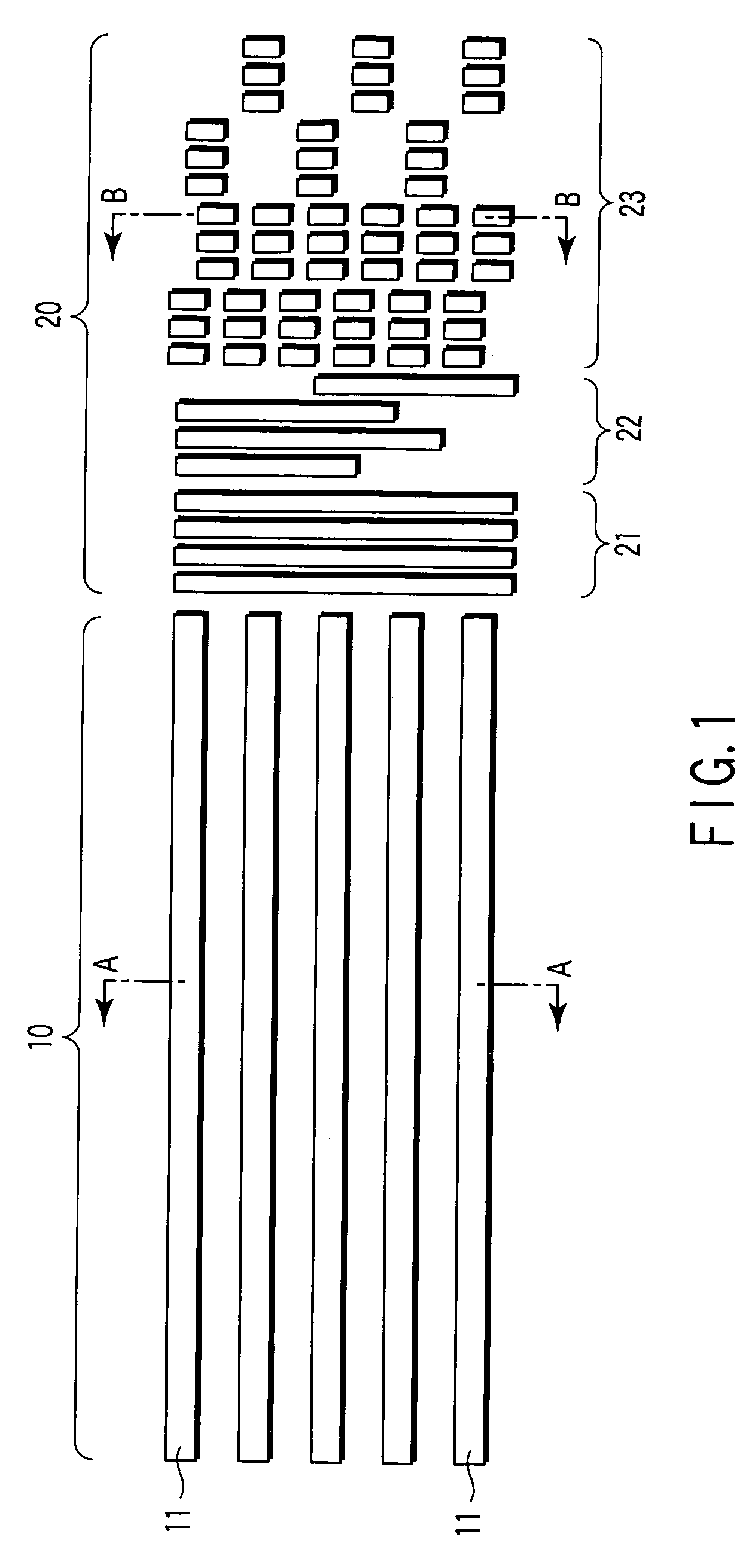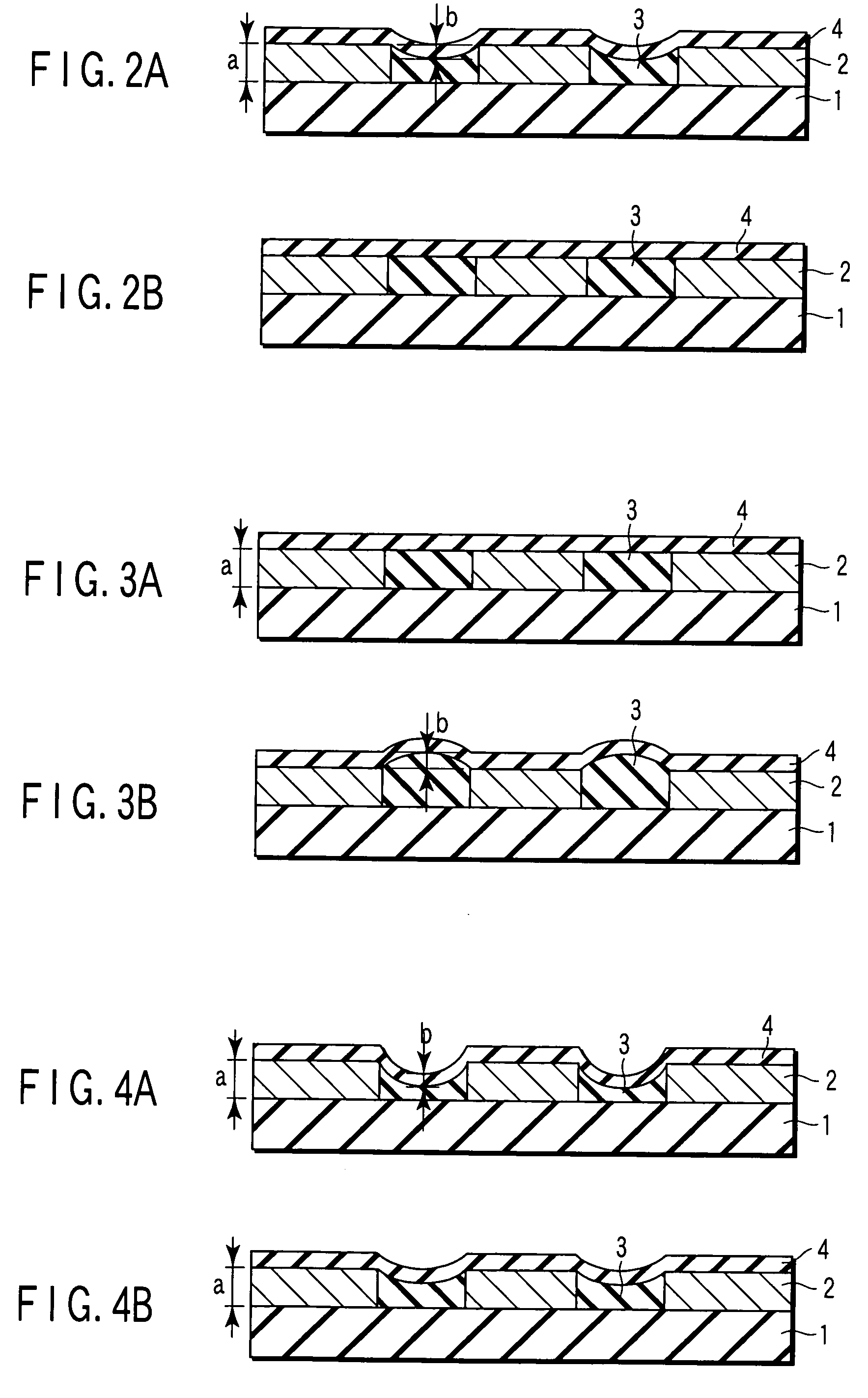Discrete track media and method of manufacturing the same
a technology manufacturing method, which is applied in the field of discrete track media, can solve the problems of difficult to allow the magnetic head to fly stably over the media surface, interfere with adjacent tracks, and achieve the effect of reducing the distance between recording tracks
- Summary
- Abstract
- Description
- Claims
- Application Information
AI Technical Summary
Benefits of technology
Problems solved by technology
Method used
Image
Examples
example 1
[0095] A disk stamper with 100 sectors of recording tracks and servo regions was formed by electron-beam exposure. The stamper was designed so that the area ratio of the ferromagnetic layer to the nonmagnetic material was 3 to 1 in the data region and 4 to 1 in the burst zone. The stamper was used to produce a discrete track media according to the method shown in FIGS. 6A to 6H, as described below.
[0096] A soft magnetic layer of CoZrNb was formed on a glass substrate to a thickness of about 200 nm. A Ru underlayer for orientation control was deposited to a thickness of about 20 nm by sputtering. A ferromagnetic layer formed of CoCrPt alloy added with SiO2 was then deposited to a thickness of about 20 nm. To prevent natural oxidation, a carbon protective film was deposited on the surface of the ferromagnetic layer to a thickness of about 4 nm. The media was determined to have a coercivity of 5 kOe on the basis of a Kerr hysteresis loop. A resist of SOG was formed so as to have a thi...
example 2
[0101] The experiment described below was conducted in order to examine the magnetic head for vibration that may occur if there is a large difference b in the height of the nonmagnetic material between the burst zone and the data region.
[0102] As shown in FIG. 9, a DTR media was manufactured in which no servo patterns were formed, while only the data regions are processed. As shown in FIG. 10A, protrusions and recesses are present in the data region. However, as shown in FIG. 10B, the burst zone is formed into a mirror state. A milling time was varied to produce three types of DTR media in which the protrusions had a height of 20, 15, or 10 nm in the data region. The height of the protrusions corresponds to the difference b in the height of the nonmagnetic material between the burst zone and the data region. A laser Doppler vibrometer (LDV) was used to observe the head flying. For the DTR media with 20 nm of b value, vibration of 9 kHz was observed which corresponded to a frequency...
example 3
[0103] Besides SiO2, Au, Ag, Cu, C, CN, Si3N4, BN, TiN, SION, SiC, BC, TiC, or Al2O3 was used as a nonmagnetic filling agent. A DTR media was produced in a manner similar to that used in Example 1 except for this condition.
[0104] When Au, Ag, or Cu was used as the filling agent, both the data region and burst zones had a flat filled structure owing to reflow. When C, CN, Si3N4, BN, TiN, SiON, SiC, BC, TiC, or Al2O3 was used as the filling agent, sectional TEM observation showed that the DTR media produced had the structure shown in FIGS. 2A and 2B. However, in these DTR media, the film was stripped off the disk surface in places. Here, when C was used as the filling agent, the film strip-off occurred only in a relatively small number of places. These results are probably due to the difference in adhesion between the patterned resist (SOG) and the filling agent. That is, SOG and SiO2 are substantially the same material and adhere excellently to each other. However, the other materia...
PUM
| Property | Measurement | Unit |
|---|---|---|
| height | aaaaa | aaaaa |
| thickness | aaaaa | aaaaa |
| coercivity | aaaaa | aaaaa |
Abstract
Description
Claims
Application Information
 Login to View More
Login to View More - R&D
- Intellectual Property
- Life Sciences
- Materials
- Tech Scout
- Unparalleled Data Quality
- Higher Quality Content
- 60% Fewer Hallucinations
Browse by: Latest US Patents, China's latest patents, Technical Efficacy Thesaurus, Application Domain, Technology Topic, Popular Technical Reports.
© 2025 PatSnap. All rights reserved.Legal|Privacy policy|Modern Slavery Act Transparency Statement|Sitemap|About US| Contact US: help@patsnap.com



